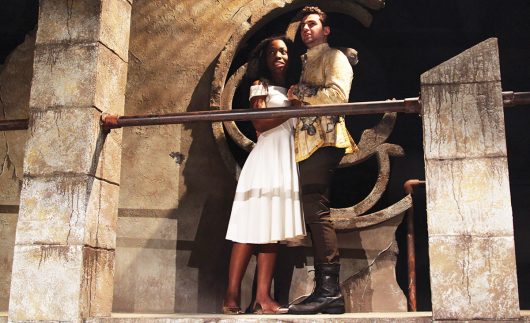
Kahla Tisdale and Joe Kopyt perform as Juliet and Romeo in The Ohio State University Department of Theatre’s production of Romeo and Juliet. Credit: Courtesy of Matt Hazard
Audience members attending the Ohio State Department of Theatre’s production of “Romeo and Juliet” should not expect a traditional performance of the classic play. The production will be an abridged version of William Shakespeare’s text adapted by guest director Alison Bomber.
Bomber is an English director with a background in voice and speech. Her work has primarily focused on Shakespearean language, and she is the former senior text and voice coach for the Royal Shakespeare Company, an England-based organization that presents modernized Shakespearean productions around the world. Bomber previously collaborated with the OSU Department of Theatre, directing its 2011 production of “Othello,” as a part of the Royal Shakespeare Company’s partnership with OSU which lasted from 2009-2016.
“Words have always been the center of everything for me,” Bomber said. “There’s something Shakespeare does with words that’s the same as music — it cuts straight to the human soul.”
“Romeo and Juliet” tells the tragic story of two star-crossed lovers who come from warring families. The five-act play, which typically lasts around three and a half hours, has been reduced to 100 minutes.
“It’s really painful,” Bomber said of cutting down the text. “There’s no way you can get all the bits you love. What I tried to do is allow the story to hang there clearly. Then there’s a process of cutting back, finding what you can live without.”
Other than some reduced lines, there are not many changes to the piece, said Zack Meyer, a second-year graduate student in acting, who plays Mercutio and other characters. The main change, he said, was the speed.
“It has a very fast pace to it, there’s no intermission,” Meyer said. “Through that application of cutting it down, the audience really feels the pace and speed in which actions take place in a week in the world of the play. So it keeps it moving, it kind of pulls harder to the core of the play and issues in the play.”
Much like in Shakespeare’s time, the play is performed by a small acting troup of nine actors for OSU’s production. Between them, the cast portrays 20 roles.
“We have some crazy costume changes. We are in a life of debt to the crew backstage helping us,” Meyer said. “But we also have to apply different acting nuances between characters to make them more distinguishable. We have a hefty task ahead of us to make sure all of that is well-defined and people can grasp onto those switches more easily.”
Joe Kopyt, a graduate student in acting who plays Romeo and Abraham, said the show requires a lot of energy and athleticism.
“Some emotional turns are so extreme because we’ve cut within scenes and sometimes between sentences,” Kopyt said. “There’s no time to languish in thoughts and emotions. You move on and sometimes it’s a 180 (degree turn), sometimes you’re happy in one sentence and terrified in the next.”
Members of the cast had praise for Bomber and her style focused less on internalization and more on speech.
“I’ve never worked with a director like Alison and just her process since Day One, when we were starting the work,” said Kahla Tisdale, a graduate student in acting who portrays Juliet and Gregory. “It’s challenging, but I’ve found, as an actress, strengths working with her, and working with her made Shakespeare less intimidating. She made it relatable and easy to understand and didn’t take as long to get in character. We found energy from her energy.”
Linnea Bond, a graduate student in acting who plays Friar Lawrence and other characters, said she fell in love with Shakespeare after seeing a production by the Royal Shakespeare Company in England as a child. She said working with Bomber has been phenomenal.
“Her connection to Shakespeare’s language is amazing,” Bond said. “She’s constantly pushing us to embody words and sounds. We focus not only on what a character is saying but how — what words they’re choosing. She showed us the power of consonants and vowels and how they use consonants and vowels to tell a story. It’s been great to work with her in that way.”
Bomber said this production of “Romeo and Juliet” is an example of what theater education can create.
“Because it’s a learning institution, we can experiment,” Bomber said, “We’re engaging in a theatrical experience.”
Ultimately, Bomber said she wants to make people feel the same way audiences did when they first saw the show 400 years ago.
“This is when 80 percent of people don’t read and write,” Bomber said. “Language is all hearing then. You couldn’t just look up a word in a dictionary, you speak them aloud.”
“Romeo and Juliet” will be performed in the Roy Bowen Theater in the Drake Performance and Event Center, beginning Wednesday. The show runs through Oct. 30 with performances Wednesday through Sunday at 7:30 p.m each night with a 3 p.m. matinee on Sunday. Tickets are $20 for the general public; $18 for OSU faculty, staff, Alumni Association members and senior citizens; and $15 for students and children.
Correction Oct. 20: An earlier edition of this article misidentified the percentage in the second-to-last graf.


